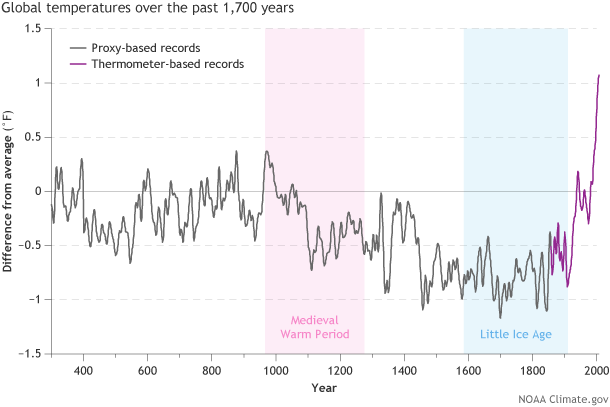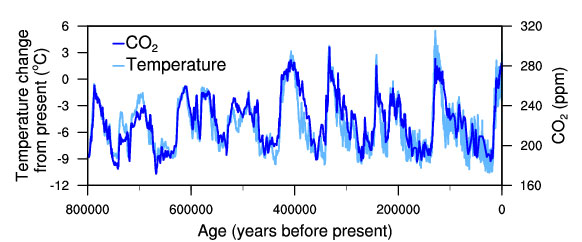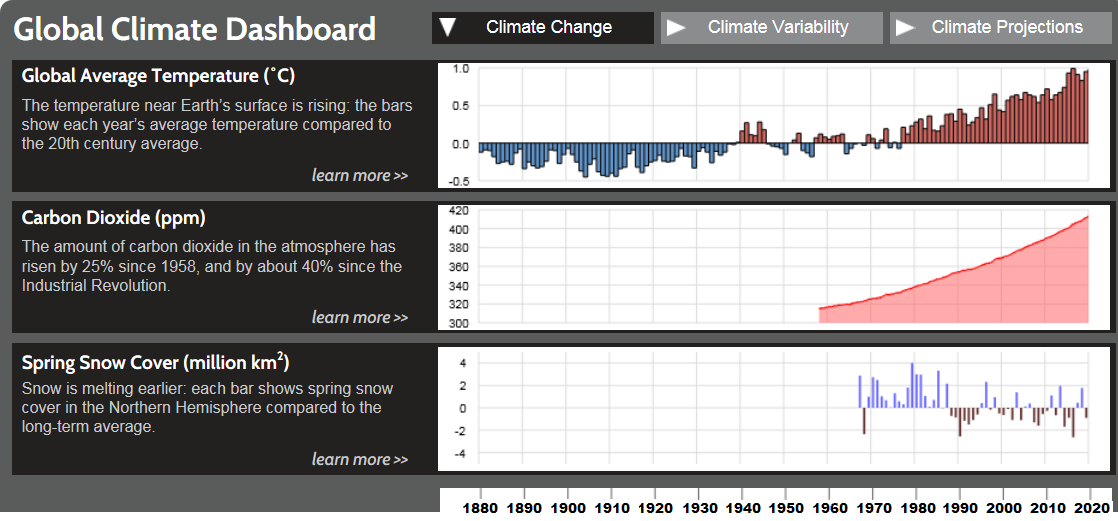
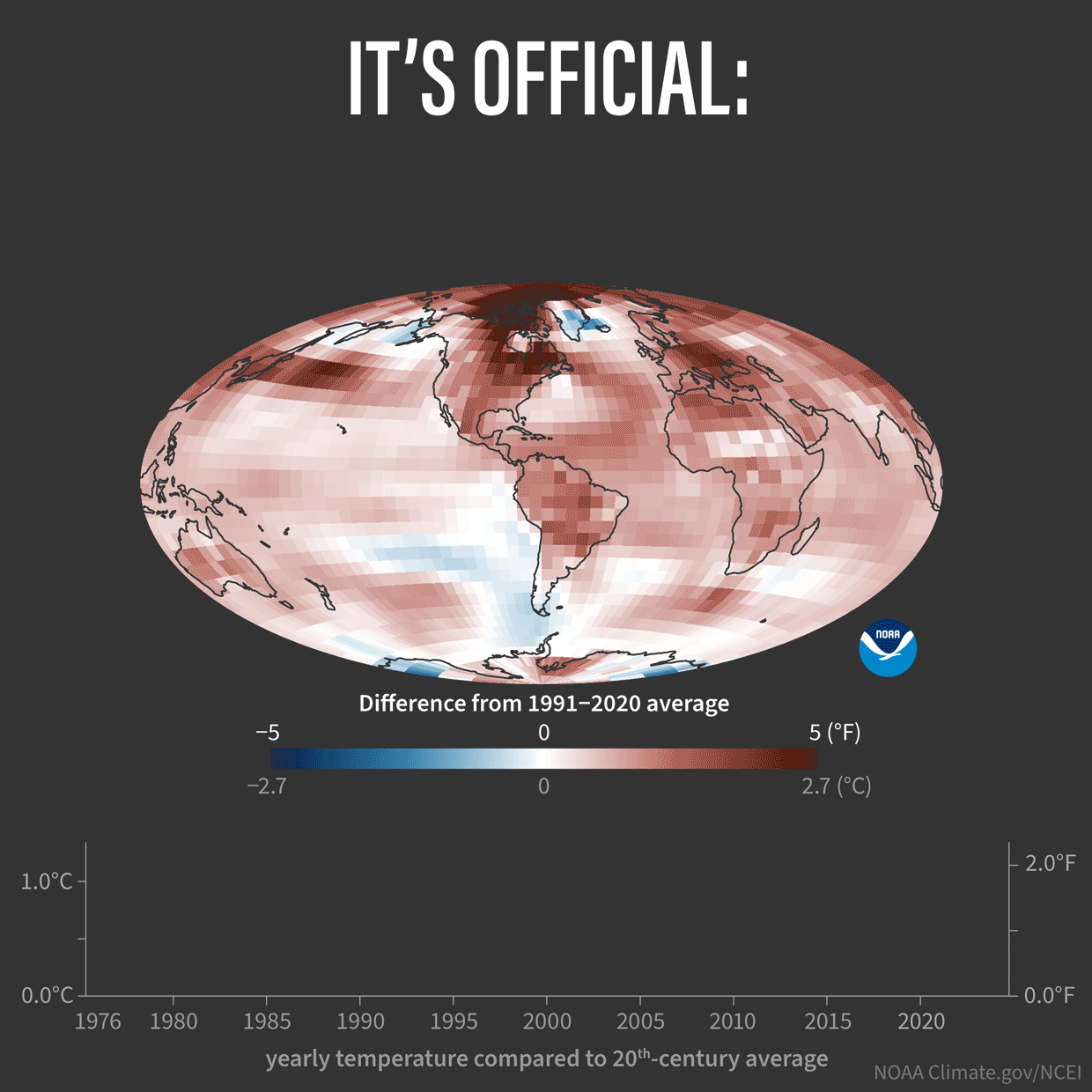 UPDATE, 2024:
UPDATE, 2024:
NOAA reports that global temperatures in 2024 were the highest since measurements began in 1850 -- over 170 years ago:
Graphic:
Temperature vs. Solar Activity
source: NASA
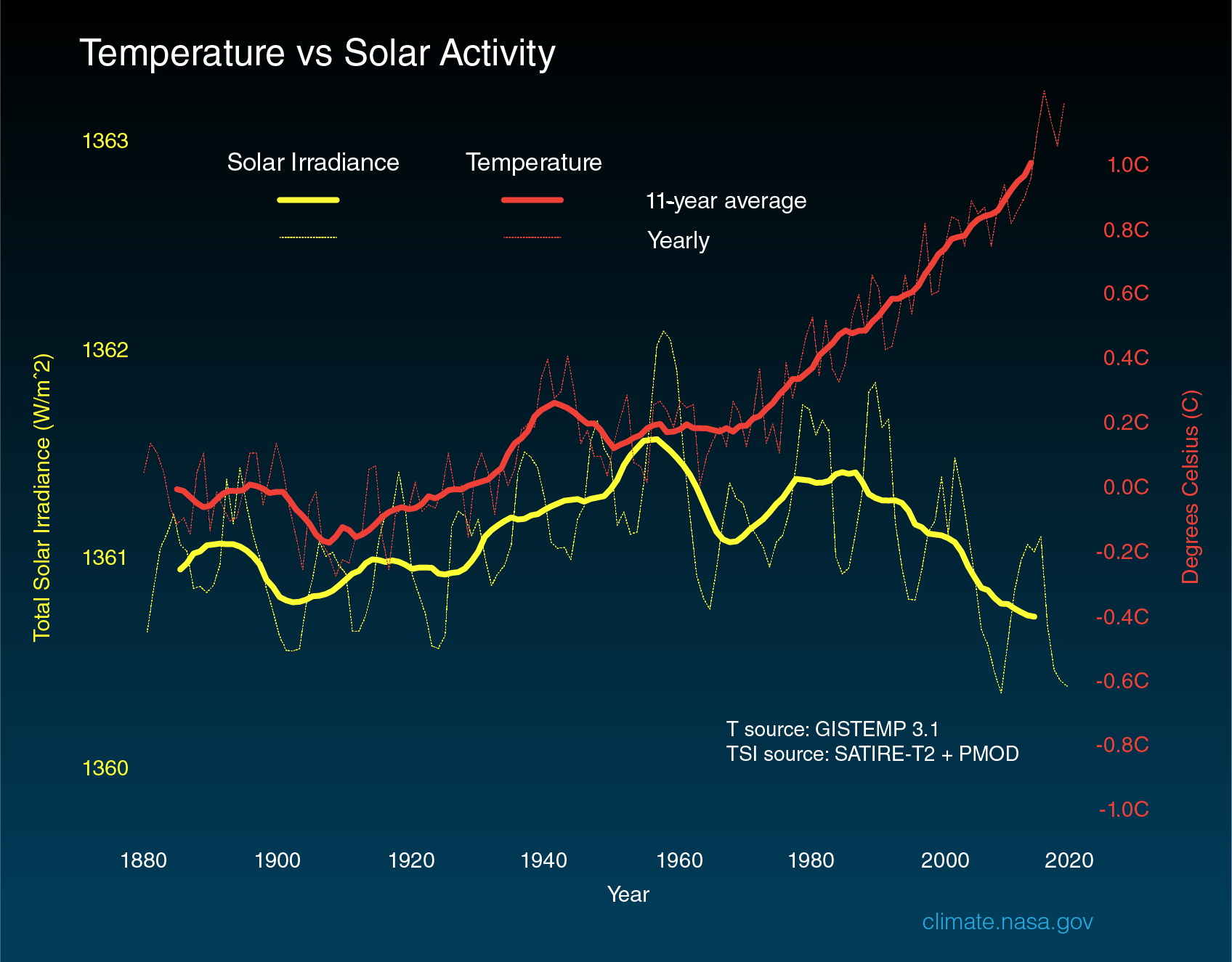
|
While some argue that solar energy is to blame for the global temperature rise, that is not the scientific record. Solar energy hitting the earth, which fluctuates on the sun's 11-year natural cycle, has (on average) remained fairly consistent, since 1880, and has recently even begun declining.
Did global warming stop in 1998?
-
Some argued, a few years ago, that global warming had halted, because the period 1998-2012 showed a lower rate of temperature rise than the years before.
This article and data disproves that wishful impression.
- Natural variability in the Pacific Ocean:
This section explains, lightly, the periodic warm-water ENSO (El Niño / Southern Oscillation) phenomenon, and its cool-water periodic opposite, La Niña, with graphs. It explains how these long cycles of ocean-water turnover can cause temporary slowing (or acceleration) of global temperature rise.- (For more detail, see:
"What is the El Niño–Southern Oscillation (ENSO) in a nutshell?"
NOAA at Climate.gov; and
"Global Climate Report - Annual 2011"
by NOAA, which gives a longer-term graph (since 1950) of the ENSO phenomenon's effect on global temperatures.)
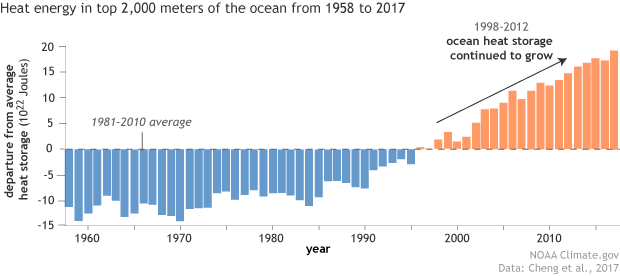 It also shows how -- although atmospheric temperature rise slowed from 1998 to 2012 -- the rising heat was, instead, largely being absorbed by the ocean (which, owing to far greater weight, can hold far more heat energy than the air).
It also shows how -- although atmospheric temperature rise slowed from 1998 to 2012 -- the rising heat was, instead, largely being absorbed by the ocean (which, owing to far greater weight, can hold far more heat energy than the air).
(NOTE: For a more detailed graph, see: "Ocean Heat Content, 1955–2015," EPA, copied on the City of Chicago official website.)
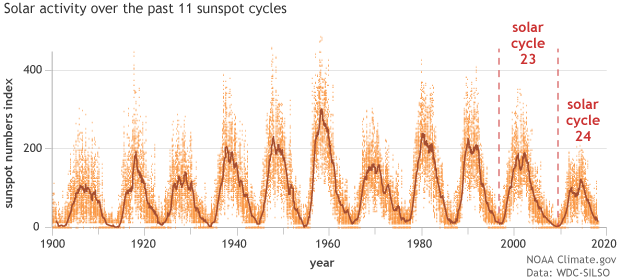
- Not your average solar cycle:
This section explains, lightly, the variability in the Sun's energy cycles, which vary the solar energy reaching the earth, noting unusual solar fluctuation, 1998-2010 (which included a longer-than-normal period of decline), with graphs.

- Sunlight-reflecting volcanic particles:
From 2000 to 2010, eruptions of several volcanoes combined to throw ash into the air, thrusting many light-reflecting particles into the stratosphere, reflecting sunlight away from the earth.
- (NOTE: Subsequent years have returned to the high rate of global temperature increase.
-
"The 10 warmest years on record have all occurred since 2005,
— and 7 of the 10 have occurred just since 2014."
- ~
Climate Change: Global Temperature
NOAA at Climate.gov )
This article explains the unusual confluence of natural factors that slowed (but did not stop) the global temperature rise during 1998-2012. (It serves also as a helpful explanation for many of the short-term transient fluctuations in global temperature, throughout time). Some of the causes of the fluctuation are detailed below :
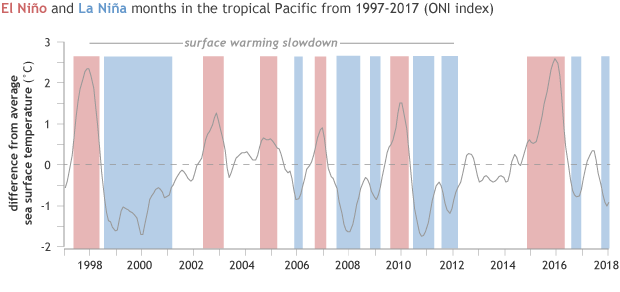
NOTE: The 1998-2012 slowing is also described, analyzed and graphed in detail at:
"Why did Earth’s surface temperature stop rising in the past decade?" ~ NOAA at Climate.gov
THE CO2 CORRELATION:
Temperature Change &
Carbon Dioxide Change
National Centers for Environmental Information, NOAA
Describes and graphs the correlation between the 800,000-year historic record of carbon dioxide in the atmosphere, and global temperature -- as determined from ancient air bubbles trapped in ice core samples and various other sources.
If Earth has warmed and cooled throughout history,
what makes scientists think that humans
are causing global warming now?
NASA Earth Observatory
-
Notes (and graphs) the 800,000-year geologic/ice record of CO2 concentrations in the atmosphere (which have generally fluctated between 180 and 280 ppm), but shows the planet's CO2 has been rising since about 1900, surpassing the 800,000-year maximum by the 1950s --
peaking at 380 ppm in 2007.
...and eight years later:
Climate Change:
Atmospheric Carbon Dioxide
NOAA at Climate.gov
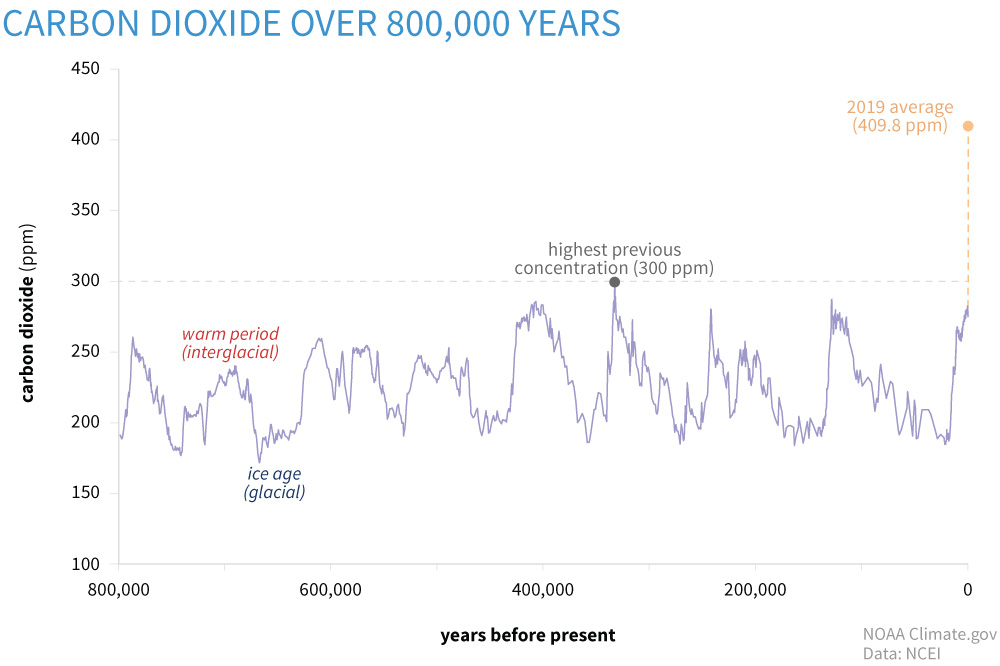 Notes (and graphs) the 800,000-year geologic/ice record of CO2 concentrations in the atmosphere (which have generally fluctated between 180 and 280 ppm) --
but marks the 2015 record of 409 ppm.
Notes (and graphs) the 800,000-year geologic/ice record of CO2 concentrations in the atmosphere (which have generally fluctated between 180 and 280 ppm) --
but marks the 2015 record of 409 ppm.
UPDATE:
May 2021, NASA:
LATEST MEASUREMENT:
416 ppm
............................................
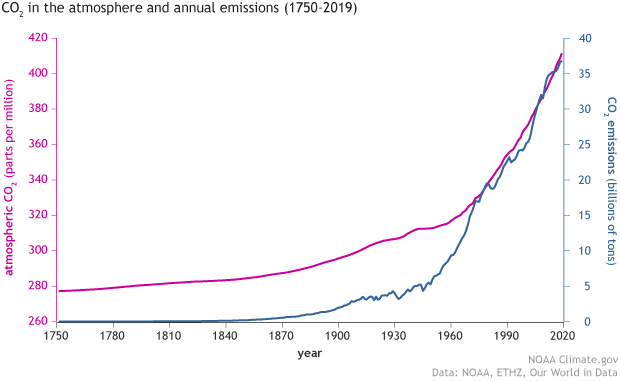 Notes (and graphs) the last 250 years of human existence -- starting in 1750 (at the beginning of the development of modern technology).
Notes (and graphs) the last 250 years of human existence -- starting in 1750 (at the beginning of the development of modern technology).
Graph shows the noticeable upswing in both carbon dioxide and atmospheric temperatures with the beginnings of the Industrial Revolution (late-1800s), and the sharp upswing with modern industry in Europe, America and Japan in the 1930s/1940s (World War II), then accelerating upwards to the present, as the whole world industrializes.
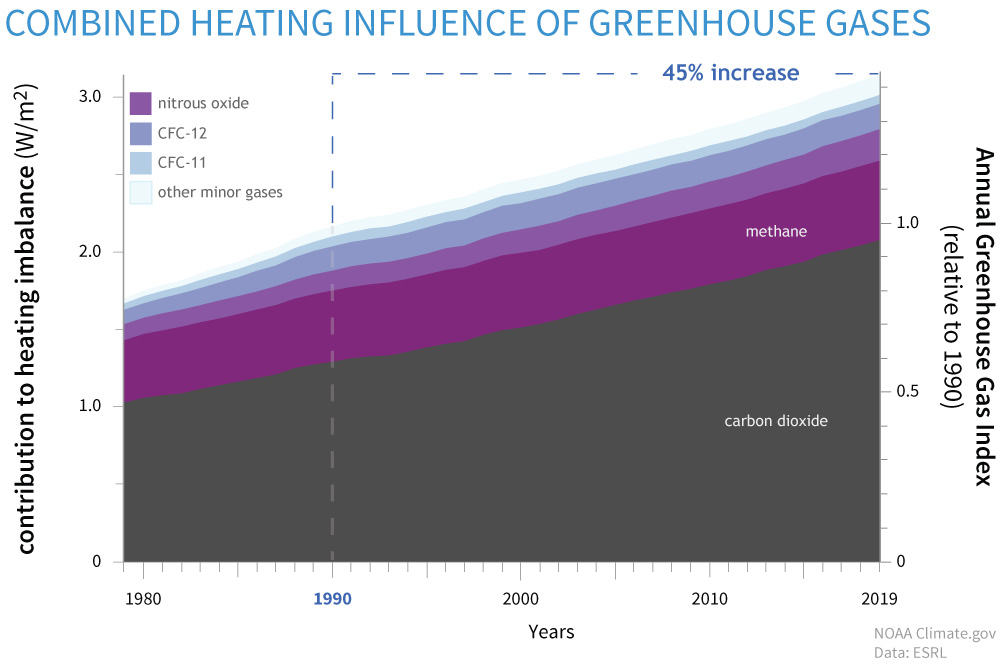 ...and includes this graph that shows
...and includes this graph that shows
the recent (since 1980) rise of
not only carbon dioxide, but
also additional "greenhouse gasses."
Climate Change Indicators:
Global Greenhouse Gas Emissions
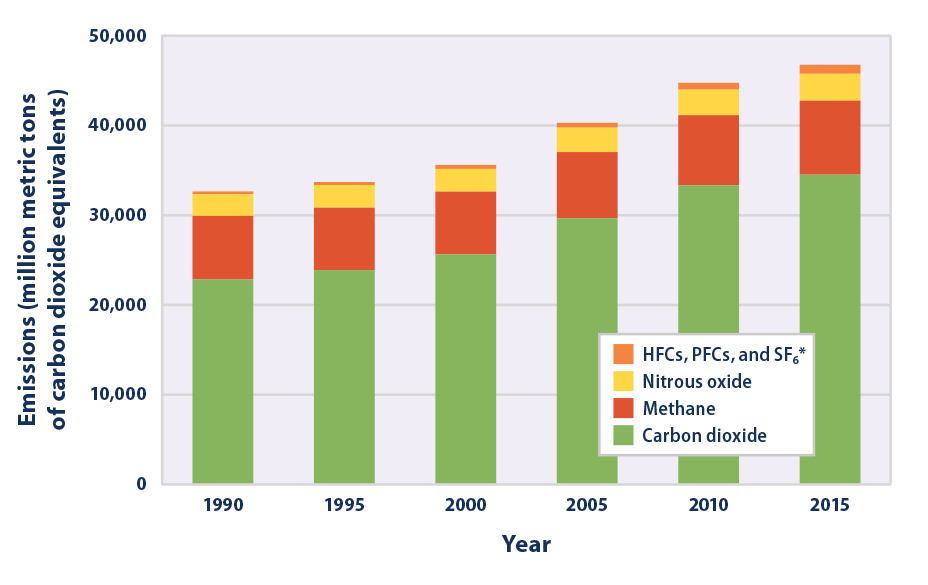
1990-2015
EPA
An overview of "greenhouse gas" emissions, 1990-2015,
as calculated from various sources.
Note carefully: While the graph (in green bars) shows actual tons of carbon dioxide dumped into the atmosphere, the other colors show the carbon dioxide equivalent (in terms of their effect on climate temperature) of the other gasses -- not their actual amounts in the atmosphere. For instance, methane actually exists in the atmosphere in a tiny fraction of the amount of carbon dioxide. But methane is a FAR more potent "greenhouse" gas. So just a "sliver" of methane in the atmosphere has as much impact as a huge chunk of carbon dioxide. Hence, methane is shown as a big orange chunk -- its size based on scientific studies and calculations.
Agreement by multiple science agencies on Earth's temperature changes since 1880.
NASA
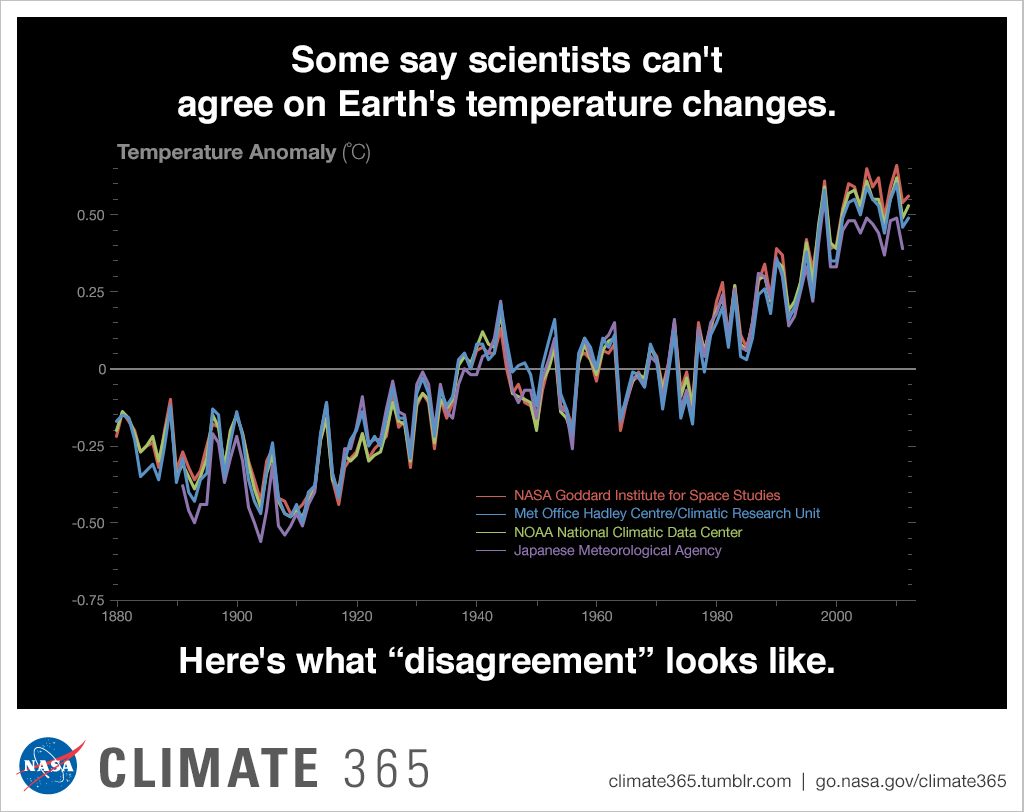
"Examining the Scientific Consensus on Climate Change"
study by
Peter T. Doran & Maggie Kendall Zimmerman,
Earth and Environmental Sciences Dept.,
University of Illinois at Chicago
in
Eos, Vol. 90, No. 3; January 20, 2009
(for free download from Wiley.com, click here.)
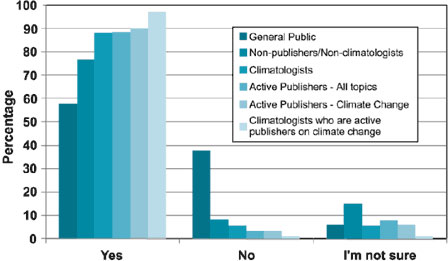
This survey attempted to provide a neutral, standardized survey of earth-science scientists, to determine the extent to which they believed that global warming exists, and is partly man-made.
The survey was sent to thousands of U.S. geoscientists who contract with the U.S. government or who are at a U.S. university (90% of respondents) -- and geoscientists from other countries (10%). The researchers sent the survey to 10,257 Earth scientists:
- 5% climate scientists,
- 15% geochemists,
- 12% geophysicists,
- 10% oceanographers,
- 5-7% each for
- geologist
- hydrologist/hydrogeologist
- paleontologist
The contact list came from a Keane & Martinez document [2007], listing...
- All "geosciences" faculty practicing at the reporting academic institutions;
- Researchers at state geologic surveys connected to local universities;
- Researchers at U.S. federal government research facilities
(e.g., U.S. Geological Survey, NASA, NOAA facilities; U.S. Dept. of Energy national labs; etc.).
The main questions:
- "When compared with pre-1800s levels,
do you think that mean global temperatures
have generally risen, fallen, or remained relatively constant?" - "Do you think human activity
is a significant contributing factor
in changing mean global temperatures?"
The web-based survey gained 30% response rate (typical of such surveys), with a total of 3,146 respondents.
PUBLIC DISAGREEMENT with MOST SCIENTISTS:

Of ALL scientist-respondents,
and
HOWEVER...
those more specialized in climate science,
and those more actively publishing "peer-reviewed" scientific research,
(research independently evaluated-and-validated by other scientists)
were even more likely to give those responses.
Of all responding climate scientists who are actively publishing on climate change,
By comparison,
a recent Gallup poll
found indications that
only 58% of the general public
would answer "yes" to Question 2.
The 'Scientific Consensus on Climate Change':
Doran and Zimmerman Revisited
by Murray Goot, Macquarie University
-
This academic paper critically analyzes the Doran/Zimmerman study of scientific consensus on global warming (above), and concludes that its sampling technique was valid, and different sampling methods would have yielded the same results;
the Doran/Zimmerman findings appear valid.
A concise (but incomplete) rebuttal of climate-change deniers,
addressing their most common arguments,
(citing major scientific sources in response) is found at:
Common Denier Arguments
Governor's Office of Planning and Research
State of California
(Click on each argument to see a scientific response,
generally with links to sources.)

"The Science of Why We Don't Believe
Science"
by Chris Mooney, Mother Jones, April 18, 2011
Although this is in a liberal publication, and chiefly cites conservatives as resisting science, it also cites examples of liberals rejecting science. It explains the notion of "motivated reasoning" -- picking the facts you want to consider, and how you consider them, to support the conclusion you want to believe. It points out how bias can (consciously or unconsciously) intercept and control your reasoning, and even substitute for it.
